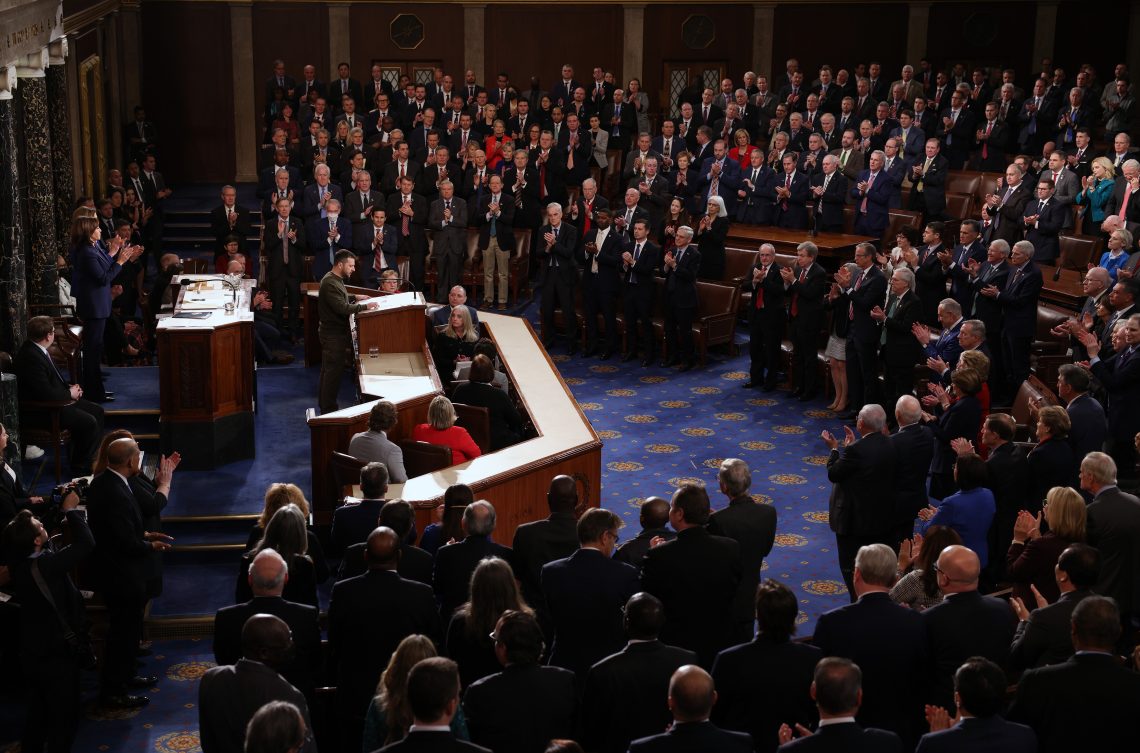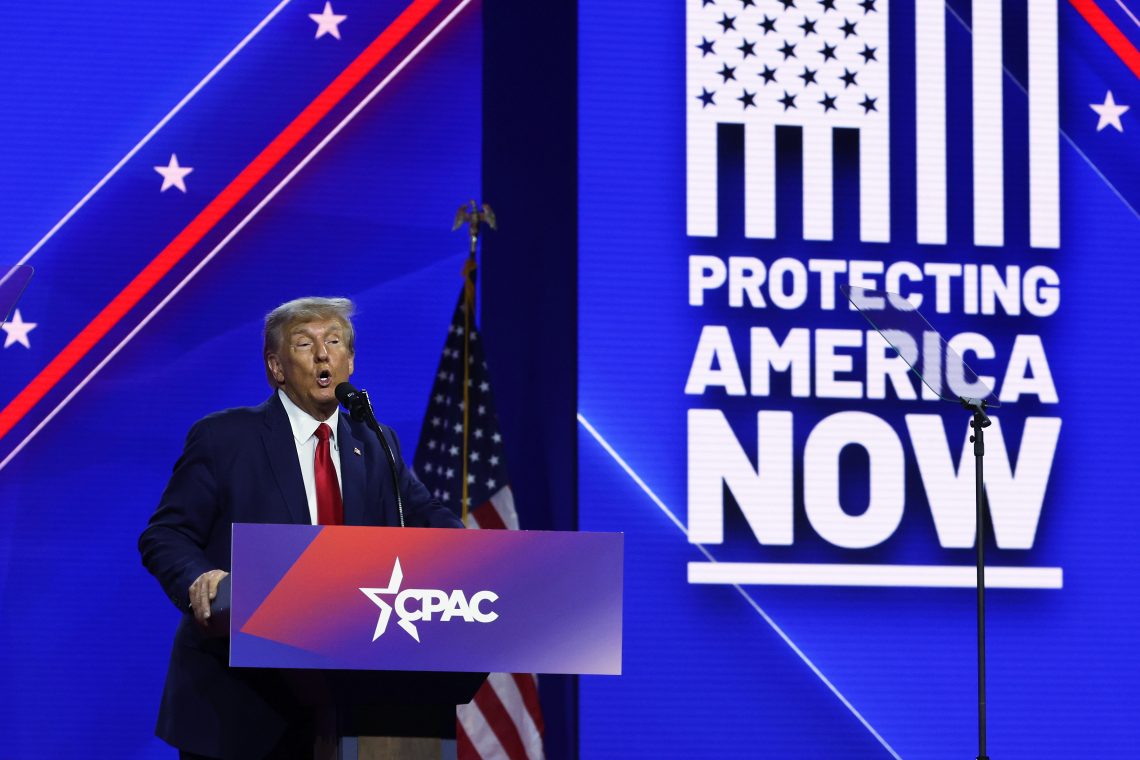The U.S. Republican schism on Ukraine
The current American debate over funding for Ukraine’s war effort exposes a fundamental divide among conservatives, with potentially dire consequences for Kyiv.

In a nutshell
- Donald Trump is a fault line in the Republican debate on Ukraine
- Voters support Ukrainian sovereignty but are queasy about indefinite assistance
- The next administration is likely to calibrate aid to contain, not decide, the conflict
Despite media coverage suggesting that most Republican lawmakers in the United States are reticent about sending more military aid to Ukraine, the truth is more complex. The ongoing tension within Republican Party circles regarding Ukraine aid is a window into the soul of conservative American politics, carrying profound geopolitical implications. While the issue partly breaks across the Trump divide, as one might expect, this is only part of the story. This report explores the multifaceted nature of the schism, its impact on support for Ukraine and the broader malleability of the conservative American electorate.
Donald Trump vs. Never-Trump
One axis of the Republican divide over continued funding for Ukraine is the dichotomy between supporters and opponents of Donald Trump.
The so-called “Never-Trump” camp within the party is more supportive of Ukraine, arguing (in some cases for years) that Russia represents the most pressing geopolitical threat to American interests. Those aligned with the former president generally echo his caricature of Ukraine as a den of corruption, and are more inclined to admire, rather than condemn, Russian President Vladimir Putin. This split largely mirrors that between “establishment” Republicans and their “anti-establishment” colleagues.
Despite a traditional Republican affiliation with hawkish foreign policy and a lingering anti-Russia impulse that sees America as a bastion against totalitarianism, the party is more focused on other questions about its worldview and the role of the American state. Today, the conservative electorate is pervaded by a sense that political elites have long maintained a “swamp” of entrenched interests – an ennui that Donald Trump has effectively mobilized into a revolutionary, anti-institution sentiment.
Support for Ukraine feeds into both ends of this narrative. Many patriotic Americans (primarily right-leaning military veterans) have volunteered to fight in Ukraine – only to find upon their return that their rural conservative brethren sneer at the Ukrainian flag as a symbol of establishment, “Republicrat” sell-outs.
Cross-cutting lines
Among Congressional Republican lawmakers, there are figures like Senator Rand Paul and Rep. Thomas Massie (both of Kentucky), who, while not wedded to former President Trump, consider U.S. involvement in Ukraine a “recipe for war and disaster.” Though conflicted over Mr. Trump to varying degrees, these advocates for cutting aid are similarly skeptical of global intervention and the supposed “elites” who presume to know how to manage them.
In contrast, Republicans like Rep. August Pfluger (of Texas) and Rep. Mike Garcia (of California) support Ukraine funding despite having strong ties to Mr. Trump and compatible worldviews. This juxtaposition underscores a broader ideological struggle within the party. For these Trump-leaning Republicans, Ukraine is seen less as a quagmire and more as a geopolitical test of American mettle, with adversaries like China watching.
The complications over support for Ukraine cut both across and within party lines. Nevertheless, as one senior Republican strategist and former Senate candidate quipped, “not all pro-Trumpers are anti-Ukraine, but all anti-Ukrainers are pro-Trump.”
Information landscape
Much of the intellectual ecosystem behind the Republican Party is shaped by think tanks and research institutes, which are also divided on the question of U.S. support for Ukraine. For example, Kori Schake of the American Enterprise Institute, which is strongly in favor of military aid to Kyiv, has called it “very odd” that the party of Cold Warrior Ronald Reagan now behaves like “reluctant internationalists.” Some of the voices advocating an isolationist shift appear almost sympathetic toward Russia, while others simply call for a re-prioritization from Russia to more salient threats like China.
The schism within policy research circles is both cause and consequence of divisions among Republican voters. The establishment National Review magazine, which is anti-Trump and hawkish on Ukraine, has characterized conservative support for additional Ukraine military aid as a “fifty-fifty proposition” among mainstream voters.
It warns that Republican candidates who hold “an illusory understanding of the Republican electorate,” thanks to a vocal minority dominating social media channels, risk alienating the significant elements of their base that are sympathetic to Ukraine’s cause.

The debate surrounding Ukraine funding is not always based on well-understood or principled arguments from either side. The pro-Ukraine camp is influenced by a sophisticated Ukrainian public relations effort to ensure that the brutality of Russia’s invasion never strays far from world attention. Meanwhile, more perniciously, the anti-Ukraine camp is buttressed by a Russia-backed misinformation campaign. In an infamous example, false claims that Ukrainian leader Volodymyr Zelenskiy bought luxury yachts with U.S. aid money were circulated by credulous Republican lawmakers like Senator J.D. Vance and Rep. Marjorie Taylor Greene.
Looking for an endgame
To be sure, there is a sincere element to conservative reluctance over Ukraine. Many are understandably concerned that allocating resources toward a poorly established military strategy poses a national security risk. Rep. Garcia, a former military fighter pilot, expressed a widely held frustration within Republican ranks when he complained that the White House “continues to fail in its responsibility to articulate a win strategy, clearly defined and obtainable objectives, and the resources to achieve victory.”
Part of a growing faction within the Republican Party, these voices insist that American taxpayer dollars should not be spent indefinitely with no clear plan to end the Russian occupation of Ukraine. Instead, they favor a “knock-out punch” using targeted military aid, such as the Proposed Plan for Victory in Ukraine submitted by Republican leaders of the foreign affairs, armed services and intelligence committees in Congress.
Read more on the Russia-Ukraine war
- Eyewitness to war: Why Chechens fight for Ukraine
- Frictions aside, Romania remains steady in support of Ukraine
- NATO’s doctrine revolution
In the long term, however, the goal of recovering Ukrainian pre-invasion territory holds relatively little emotional sway with American voters, Republican and Democratic alike. While serving as a frontline military volunteer in Ukraine, I lost an American brother-in-arms near Minkivka – and neither his mother nor the average American voter has any idea where that is.
Likewise, they care little whether the current battlelines become the de facto eastern borders of a reconfigured Ukraine. Whether Ukraine recovers territory lost to Russia is of little concern to U.S. voters, especially if the costs of regaining it are plotted on a scale of diminishing returns.
Still, even if Mr. Trump wins the November 2024 election and isolationist conservatives successfully throttle Ukraine aid, the overall geopolitical situation is unlikely to change substantially. If Russia makes meaningful gains in Ukraine – again threatening the capital Kyiv, for example – political momentum will shift once again to favor considerable investment to prevent such an outcome.
This duality – voters caring little about the specific details of how the conflict is going but caring greatly about preserving Ukraine’s ultimate sovereignty – underscores the complexity of the issue and the challenges facing conservative advocates of U.S. support for Kyiv.
Scenarios
Highly unlikely: A significant (20+ percent) increase in Ukraine aid
Republican infighting will likely preclude any dramatic additional funding appropriations, even if they are tied to other party priorities, like border security. Even with an (unlikely) 2024 Democratic sweep of the House, Senate, and presidency, there would be difficulty justifying an increase in funding for Ukraine significant enough to finance a rollback of Russia’s gains in the Donbas region. Americans are weary of trillion-dollar price tags.
Similarly, under a government divided between the two parties, even if the White House could creatively skirt Congressional purse strings (as it has done before), this is unlikely to produce the kind of extraordinary investments required to change the course of the war. The Republican schism, in short, reflects American popular sentiment about the conflict.
Somewhat likely: Stable aid flows or a small increase
If Russia were to break through the current lines in any substantial manner over the next year – for instance, with a successful Kharkiv offensive or a Transnistria breakout – it is likely that U.S. aid, coupled with other international donors, would meet or even exceed earlier levels. So-called “lethal aid,” which in such circumstances carries far greater political clout than ill-defined “government support,” would be easily justified in such a scenario, even with a divided Republican caucus. The “America First” element would have a difficult time prevailing with an isolationist position in the face of genuinely pressing threats to Europe and NATO. As such, the Republican divide is in an important sense conditional.
More likely: Limitations on aid
The next president, whether a Republican or Democrat, is most likely to crudely calibrate aid appropriations to contain the conflict roughly within the current battlelines. While Americans are generally eager to see Ukrainian advances, they will not fund them indefinitely. It is irrelevant to U.S. voters, for instance, whether the eastern border of Ukraine is marked by the Derkul River or the Sievierodonetsk Canal (the pre- and post-invasion borders, respectively).
Nevertheless, the steady bleeding of a geopolitical foe bogged down in the Donbas is a desirable prospect for American strategic interests – and an objective that both sides of the Republican schism can agree on.
For industry-specific scenarios and bespoke geopolitical intelligence, contact us and we will provide you with more information about our advisory services.









